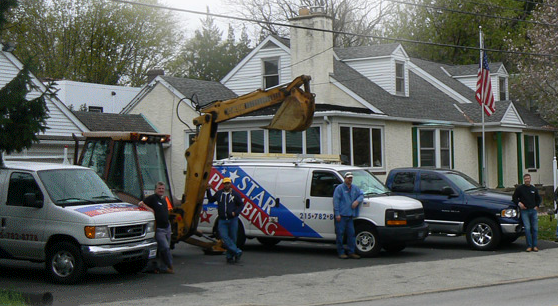How To Install Vanity and Plumbing: A Step-by-Step Guide
Installing vanity and plumbing is a challenging but rewarding task. This guide will help you understand the basics of installing vanity and plumbing, including the tools and materials you will need and the steps involved.
Understand Materials Needed
Before beginning to install your new vanity, it is important to understand what materials and supplies you will need for the task. First, you will need to make sure you have the correct tools for the job, such as a wrench, pliers, and pipe cutters. You will also need new plumbing parts for the sink installation, such as a drain trap and shut-off valves. Additionally, you may need additional materials depending on your specific installation needs, such as a water line kit or additional pipes.
Shut Off The Water Supply
Once you have all of the necessary materials ready to go, it is important to shut off the water supply before beginning any work on the vanity. This can be done by turning off the main water valve connected to your home’s plumbing system or turning off individual shut-off valves located near each sink or fixture. It is important to ensure that all of the water is completely turned off before beginning any installation work.
Remove The Old Vanity
The next step in installing a new vanity is removing the old one from its current location. This can be done by unscrewing any screws or bolts that are holding it in place and then carefully lifting it out of its position. Once removed from its current location, it should be placed in an area where it can be disposed of properly.
Assemble The Plumbing Parts For Sink Installation
Once the old vanity has been removed and disposed of properly, you can begin assembling all of the necessary plumbing parts for sink installation. This includes connecting all of the different pipes together via fittings and fasteners, as well as attaching shut-off valves if needed. It is important to make sure that all connections are secure before proceeding with any further work on the vanity installation.
Measure The Drain Locations In Your New Vanity
The last step in installing your new vanity involves measuring out and marking where each drain should go in order to ensure a proper fit during installation. This can be done by using measuring tape and marking each spot with a pencil before drilling any holes into place for the drains themselves. Once all drain locations have been measured out correctly and marked accordingly, you should be ready to install your new vanity!
Cut any large holes in the vanity top to fit it around drains
It is important to make sure that any large holes in the vanity top are cut properly in order to fit it around drains. This step is often overlooked but is essential for a successful installation. You will need to measure the area where the drain needs to be installed and then use a drill or jigsaw to make the necessary cuts. Make sure that all of the cuts are precise and even so that they fit snugly around the drain. It is also important to use a sealant or other adhesive material on the edges of the cuts so that they stay sealed and don’t allow water to seep through.
Install the tailpiece and P-trap for drain connection
Next, you will need to install the tailpiece and P-trap for drain connection. Start by unscrewing the old tailpiece from underneath your vanity top. Then, measure out where you need to cut a hole for your new tailpiece and make sure it fits securely in place before continuing on with your installation. Once everything is secure, connect your P-trap onto your tailpiece using plumber’s tape and nuts, followed by connecting it onto your sink’s drain line.
Attach supply lines to the angle stops and faucet
The next step is attaching supply lines to the angle stops and faucet. Begin by measuring out how much pipe you will need for each line and cutting them accordingly. Then attach one end of each pipe onto an angle stop, making sure they are securely tightened with plumber’s tape or nuts as needed. Next, attach them onto your faucet using appropriate connectors or adapters as needed. Finally, make sure everything is tightly secured and there are no leaks before moving on with your installation.
Make sure all parts are securely attached to one another
Finally, once all of your parts have been installed, it is important that you double check that all parts are securely attached to one another with no loose connections or potential leak points present. This includes ensuring that all screws are firmly tightened into place, seals are intact on pipes, valves have been properly adjusted, etc… Once everything has been checked off then you can move forward with finishing touches like attaching handles or other decorative elements as desired before enjoying your new vanity setup!
FAQ & Answers
Q: What materials do I need to install a vanity and plumbing?
A: You will need the vanity itself, plumbing parts for sink installation such as tailpiece, P-trap, supply lines and angle stops, as well as any tools necessary to assemble the pieces.
Q: How do I shut off the water supply before installing a vanity and plumbing?
A: To shut off the water supply you can locate the main shutoff valve for your home. This should be located in a utility room or near an outside wall. Turn it clockwise until you cannot turn it anymore.
Q: What should I do before installing a new vanity and plumbing?
A: Before installing a new vanity and plumbing, you will need to remove the old vanity first. You will also need to measure the drain locations in your new vanity and cut any large holes in the top of it to fit around drains.
Q: How do I attach supply lines to angle stops and faucet?
A: To attach supply lines to angle stops and faucet, use flexible tubing that is compatible with your existing pipes. Connect one end of each supply line to an angle stop located behind your faucet and then attach the other end of each line to the faucet itself. Make sure all connections are securely tightened before turning on the water supply.
Q: How can I make sure all parts are securely attached when installing a new vanity and plumbing?
A: To ensure that all parts are securely attached when installing a new vanity and plumbing, take care when connecting pieces together such as tailpiece, P-trap, supply lines, angle stops and faucet. Tighten all connections using appropriate tools such as wrenches or pliers until they feel secure but not overly tight. Test for leaks before turning on water supply by running some water through each connection point.
In conclusion, installing a vanity and plumbing is a relatively simple task, if done correctly. It is important to ensure that the vanity and plumbing are properly connected and that the water lines are secured. Additionally, it is important to make sure that the vanity cabinet and sink are securely mounted. With these steps in mind, you should be able to install your vanity and plumbing in no time!
Author Profile

-
Star Plumbing, located in Elkins Park, PA, is a full-service plumbing company owned and operated by Mitchell Gordon. Since its inception, Star Plumbing has been providing its customers with reliable, quality plumbing services.
The Star Plumbing website offers informative articles on DIY plumbing and plumbing equipment, offering readers helpful advice and tips on how to take care of their own plumbing needs. This is a great resource for those who are looking to tackle a plumbing project themselves, as it provides useful information and advice on how to safely and successfully complete a plumbing job. Additionally, the website provides detailed descriptions of the various plumbing tools and equipment that are available, as well as detailed instructions on how to use them.
Star Plumbing’s website is a great resource for anyone with plumbing needs. Whether a customer is looking for advice on how to take care of their own plumbing or to schedule service from Star Plumbing, the website offers helpful advice and information for all their plumbing needs.
Latest entries
- April 12, 2024Plumbing Equipment And AccesoriesI Tested And Ranked The Best 10 Inch Rough In Round Toilet In 2024: And Here’s What I Found
- April 12, 2024Plumbing Equipment And AccesoriesI Tested And Ranked The Best Stone That Cleans Toilets In 2024: And Here’s What I Found
- April 12, 2024Plumbing Equipment And AccesoriesI Tested And Ranked The Best Heat Tape For Plumbing In 2024: And Here’s What I Found
- April 12, 2024Plumbing Equipment And AccesoriesI Tested And Ranked The Best Kaboom Toilet Bowl Tablets In 2024: And Here’s What I Found
